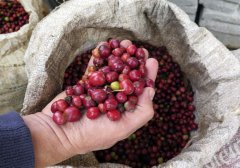Does Huofenghuang Manor have good beans? the planting and processing of single beans in Huofenghuang Manor

Professional barista communication, please pay attention to coffee workshop (Weixin Official Accounts cafe_style)
Manor Introduction:
Located in the fertile volcanic hills of Poas in the central valley of Costa Rica, the Estates de la Phoenicia is a 100% organic coffee estate that pays great attention to the concept of environmental management (column: rainwater collection for coffee treatment) and the production of organic compost using earthworm farming (worm compost) to make the cultivation process completely free of chemical fertilizers and pesticides. The owner believes organic farming is the best option for the environment and the health of his family, despite the many technical and organizational challenges.
Phoenix Manor is also the first in Central and South America to produce honey and sun coffee plantations, it produces high-quality coffee are very unique, the biggest feature is a very amazing sweet! Coffee cherries can reach 21- 22% sweetness, and during the harvest season, using the treatment often used in the wine industry, only those exceeding 20% sweetness will be exposed to sunlight.
The natural processing of sapphire (Zahiro) is quite labor-intensive. Hand-harvested cherries with high sugar content are first placed in the African elevated shed for about 10 days in the sun, and then placed in the plastic covered greenhouse to create more direct heat and continue to dry until the moisture content reaches 11.5%. The slow drying process allows the beans to develop more natural sweetness from the inside, but it also requires more care and constant stirring. At the end, the red cherries turn black, giving off aromas of fruitcake, brown sugar and even sherry!
Costa Rica Costa Rica
Population: 4586000
In the past, Costa Rica has succeeded in marketing its coffee according to the name of the producing region. However, tastes vary greatly within each region, so it's worth exploring each of the different regions to see what kind of coffee beans they produce.
CENTRAL VALLEY
Central Valley, Costa Rica's capital city San Jose is located here, which is the most densely populated area. It is one of the oldest coffee growing areas. It is usually divided into subdistricts of San José Heredia and Alajuela. Three major volcanoes in the region: Lrazu, Barva and Boaz affect the terrain and soil.
Altitude: 900- 1,600 m
Harvest: November-March
WEST VALLEY
West Valley, the first farmer settled in the 19th century and brought coffee. The area is divided into 6 sub-regions, surrounding the urban centers of San Ramon, Palmares, Naranjo, Greece, Sarchi and Athenas. Sarchi has a specific coffee variety called Villa Sarchi. The highest elevations in the region are located around Naranjo, and some amazing coffees can be found at the elevations of this region.
Altitude: 700- 1,600 m
Harvest: October-February
TARRAZU
Tarrazu has a reputation built up over the years, and the coffee from here can almost be considered a high-quality grade. But the coffee comes from different farms and is then blended into large batches. However, Tarrazu's brand has accumulated enough strength over the years that coffee produced outside the region is also labeled Tarrazu to increase its value. Costa Rica's highest coffee farms are located in this region, and like many other regions, profitable points of time occur during the distinct dry season harvest.
Altitude: 1,200- 1,900 m
Harvest: November-March
Manor Information:
Country of Origin: Costa Rica San Francisco
Region: Central Valley
Manor Farm: Cumbres del Poas
Altitude: 1300-1500 m
Variety Varietals: Catura & Catuai caturra&catuai
Processing: Solarization
Grade:SHB 18 mesh
Harvest Time/Crop Year: 2013/2014
Manor Introduction:
Located in the fertile volcanic hills of Poas in the central valley of Costa Rica, the Estates de la Phoenicia is a 100% organic coffee estate that pays great attention to the concept of environmentally friendly treatment (column: rainwater collection for coffee treatment) and the production of organic compost using earthworm farming (worm compost) to make the cultivation process completely free of chemical fertilizers and pesticides. The owner believes organic farming is the best option for the environment and the health of his family, despite the many technical and organizational challenges.
Phoenix Manor is also the first in Central and South America to produce honey and sun coffee plantations, it produces high-quality coffee are very unique, the biggest feature is a very amazing sweet! Coffee cherries can reach 21- 22% sweetness, and during the harvest season, using the treatment often used in the wine industry, only those exceeding 20% sweetness will be exposed to sunlight.
Manor Introduction:
Located in the fertile volcanic hills of Poas Valley in Central Costa Rica, the first producer of honey-treated and sun-cured coffee in Central and South America, a 100% organic coffee farm, the owner believes that organic farming is the best choice for environmental protection and family health, even though he faces many technical and organizational challenges. The high quality coffee produced by this estate is very unique, the biggest feature is that it has a very amazing sweet taste! He made a name for himself when he entered the boutique coffee contest in 2009. During the harvest season, the wine industry often uses amazing sweetness!
He made a name for himself when he entered the boutique coffee contest in 2009. During the harvest season, using the usual rules of the wine industry, only those exceeding 20% sweetness will be sunburned. The Brix value of ordinary fruits is 14 for apples, 12 for lemons and 18 for passion fruits, but coffee cherries for phoenix can reach 21- 22%.
The estate attaches great importance to the concept of environmentally friendly treatment (column: rainwater collection for coffee treatment) and uses earthworm farming (worm compost) for the production of organic compost to make the planting process completely free of chemical fertilizers and pesticides.
Sapphire and black rose are two very special sun products. They use special treatment methods to prolong the drying time of sapphire and black rose on the trellis, but the difference is that sapphire is dried and fermented in a low temperature environment, while black rose is dried and fermented in a high temperature environment. After fermentation in such different temperature environments, sapphire will produce a more obvious delicate flavor and sweet feeling, while black roses are rich in strong sunlight tonality.
The natural processing of sapphire (Zahiro) is quite labor-intensive. Hand-harvested cherries with high sugar content are first placed in the African elevated shed for about 10 days in the sun, and then placed in the plastic covered greenhouse to create more direct heat and continue to dry until the moisture content reaches 11.5%.
The slow drying process allows the beans to develop more natural sweetness from the inside, but it also requires more care and constant stirring. At the end, the red cherries turn black, giving off aromas of fruitcake, brown sugar and even sherry!
Country Profile:
The Republic of Costa Rica (Spanish: República de Costa Rica), commonly known as Costa Rica (Taiwan: Costa Rica, China and Hong Kong: Costa Rica, meaning "fertile coast"), is a Central American country bordered by Nicaragua to the north and Panama to the south. Costa Rica was the first country in the world to have no army. The capital of Costa Rica is San Jose.
National Geographic:
Costa Rica is located in the narrow strip of Central America, 10 degrees North latitude; 84 degrees West longitude. It is bordered by the Caribbean Sea to the east and the North Pacific Ocean to the west, with a coastline of 1290 kilometers (212 kilometers in the Caribbean Sea on the east coast and 1016 kilometers in the Pacific Ocean on the west coast).
Costa Rica borders Nicaragua to the north (309 km) and Panama to the south-southeast (639 km). It has a total area of 51100 square kilometres, of which 50660 square kilometres are territory and 440 square kilometres are territorial waters.
It's slightly smaller than West Virginia in the U.S. and about the same size as Ireland. Costa Rica has a coastline of plains and rugged mountains in the middle. It declared an exclusive economic zone of 200 nautical miles and a territorial sea of 12 nautical miles. The climate is tropical and subtropical, and partly neotropical.
National Culture:
Costa Rica is culturally diverse and serves as a crossroads of Central and South American cultures. When the Spanish conquered America in the 16th century, Costa Rica's northern region was the southernmost territory of Mayan civilization, the central and southern regions were the territory of the Chibucha, and the west coast was inhabited by black slaves sold from Africa in the 17th to 18th centuries. It was also at this time that many Chinese farmers came here to build railways.
Costa Rican music has tambito and punto, which are very unique, such as punto guanacateco from Guanacaste province and punto sancarleno from San Carlos in Arahuila province. Much music and legends spread from northern Costa Rica (once Mayan territory) and the Atlantic coast.
Costa Rica is located in Central America. She is the first country in the world without an army. Costa Rica is progressive and peaceful, with a thriving tourism industry and its capital in San Jose. Because Costa Rica is also a neutral country with a pleasant climate and mountains, it is also known as the "Switzerland of Central America". Costa Rica has a strong Spanish colonial color, and very few archaeological artifacts remain before Columbus, so we know little about the history before colonization; however, a visit to the Museo de Jade and the National Gold Museum (Museo de Oro Precolombino) in San Jose can give you a glimpse of this forgotten history.
Coffee was introduced from Cuba in 1808, and exports began during the tenure of President Fernando de la Sierra, and continued to increase thereafter, improving the Colombian economy. Many people became rich from coffee, and social classes were created.
In 1849, Juan Rafael Mora, a coffee farmer, became president and ruled for ten years. Costa Rica borders Nicaragua to the north, Panama to the southeast, the Caribbean Sea to the northeast and the Pacific Ocean to the southwest. Although Costa Rica has a territory of only 50,100 square kilometers, its geographical structure varies greatly. A volcanic mountain range extending from the northwestern border of Nicaragua to the southeastern border of Panama, forming Costa Rica's spine and dividing the country into two parts. The Central Highland is 3820 meters above sea level, and there are various geographical and ecological environments with the ups and downs of the terrain. In the middle of the highlands lies a plain called Meseda Central, at an elevation of 1000 to 1500 michels, which houses four of Colombia's largest cities, including the capital, San Jose. More than half of the country's population lives on this fertile volcanic plain. Most of the mountains are volcanoes, some of which are active.
Fire Phoenix series, mainly Cumbres del Poas This estate located on the hillside of the volcano, not only the soil is fertile, but the owner of the estate is meticulous about the care of the environment. Although it is not organic, it is confirmed to be natural farming. In addition, through natural fertilizer control and pruning techniques, coffee beans have high hardness and rich layering characteristics. Deep sun, is to let the coffee fruit early drying, then move to the indoor slowly do fermentation control, get wine fermentation flavor rich, but also with red wine lively texture of the atmosphere.
Baking degree: medium baking
Costa Rica Central Valley Cumbres del Poas Black Rose
Coffee growing area: Cetral Valley
Annual rainfall: 3000 mm
Coffee Breed: Caturra Catuai
Annual average temperature: about 20 degrees
Treatment: Solarization
Planting altitude: 1300M-1500M
Soil type: Volcanic soil
Harvesting Method: Manual Harvesting
Costa Rica Central Valley Fire Phoenix Manor Black Rose
Located in the fertile hills of the Poas Volcanic Valley in central Costa Rica,
It was the first producer of honey-treated and sun-cured coffee in Central and South America.
Is a 100% organic coffee plantation,
Planters believe organic farming is essential for environmental protection
Health with family is the better option,
This belief persisted despite many technical and organizational challenges.
The high quality coffee produced by this estate is very unique,
The biggest feature is that it has a very amazing sweetness!
He made a name for himself when he entered the boutique coffee contest in 2009. During the harvest season,
Using the Brix meter that the wine industry often equips,
to measure the sugar content,
According to Brix's sugar content, the best harvest time and treatment method were determined.
Only those that are 20% sweeter are exposed to sunlight.
Brix values for the average fruit are 14 for apples, 12 for lemons, 18 for passion fruit,
But the coffee cherries of the fire phoenix can reach 21-22%.
The estate is very environmentally conscious (column: rainwater harvesting to process coffee),
Production and use of organic compost using earthworm farming (worm compost)
Make the planting process completely free of chemical fertilizers and pesticides.
Sapphire and black rose are two very special suntan products
They use a special treatment,
Prolonged drying time of sapphire and black rose on trellis
But the difference is: sapphire is dry fermented at low temperatures,
Black roses, on the other hand, are dried and fermented at high temperatures.
After fermentation at such different temperatures,
Sapphire will produce a more pronounced delicate flavor and sweet feeling
Black roses, on the other hand, are rich and intense in solarization.
Dry Fragrance
Bouquet, red berry, blackberry, caramel brown sugar, dark chocolate rich Body
Aroma
Melon and fruit, woody, nutty, white flowers, oolong tea
Sipping Flavor
Slightly sweet citrus and honey, with delicate nutty aromas of roasted walnut
The palate is round and full, with honey, bean curd and citrus flavors, like coffee sugar.
Everyone's taste is not necessarily what they like.
You can consider buying a small amount and trying different baking degrees.
Soy beans in an explosion
Drop the beans at the end of the explosion.
Drop the beans from the end of the first explosion to the second explosion.
Touch the beans under the second explosion.
Put the beans into the second explosion for 10-15 seconds
The second explosion of dense beans
I hope you bakers can find a more favorite flavor.
*
Important Notice :
前街咖啡 FrontStreet Coffee has moved to new addredd:
FrontStreet Coffee Address: 315,Donghua East Road,GuangZhou
Tel:020 38364473
- Prev

How to deal with the processing of Rwanda single bean? how to divide the grade of Rwanda single bean?
Exchange of professional baristas Please pay attention to the characteristics of Rwandan coffee in Coffee Workshop (Wechat official account cafe_style): flavor: soft, strong aroma, full-grained Rwandan coffee the taste of Rwandan coffee is described as grass aroma, with tropical climate characteristics, this coffee presents a sweet fruit taste, it can also make people taste fresh, clear, and fresh. What grew up in Rwanda
- Next

Introduction to the production area of individual beans in Fire Phoenix Manor how to brew single beans in Fire Phoenix Manor
Professional baristas exchange please follow coffee workshop (Wechat official account cafe_style) roasting degree: medium roasted Costa Rica Central Valley Cumbres del Poas Black Rose coffee producing area: Cetral Valley annual rainfall: 3000 mm coffee variety: Caturra Catuai annual average temperature: about 20 degrees treatment method: sun treatment method planting altitude: 1300M-150
Related
- Does Rose Summer choose Blue, Green or Red? Detailed explanation of Rose Summer Coffee plots and Classification in Panamanian Jade Manor
- What is the difference between the origin, producing area, processing plant, cooperative and manor of coffee beans?
- How fine does the espresso powder fit? how to grind the espresso?
- Sca coffee roasting degree color card coffee roasting degree 8 roasting color values what do you mean?
- The practice of lattes: how to make lattes at home
- Introduction to Indonesian Fine Coffee beans-- Java Coffee producing area of Indonesian Arabica Coffee
- How much will the flavor of light and medium roasted rose summer be expressed? What baking level is rose summer suitable for?
- Introduction to the characteristics of washing, sun-drying or wet-planing coffee commonly used in Mantenin, Indonesia
- Price characteristics of Arabica Coffee Bean Starbucks introduction to Manning Coffee Bean Taste producing area Variety Manor
- What is the authentic Yega flavor? What are the flavor characteristics of the really excellent Yejasuffi coffee beans?

